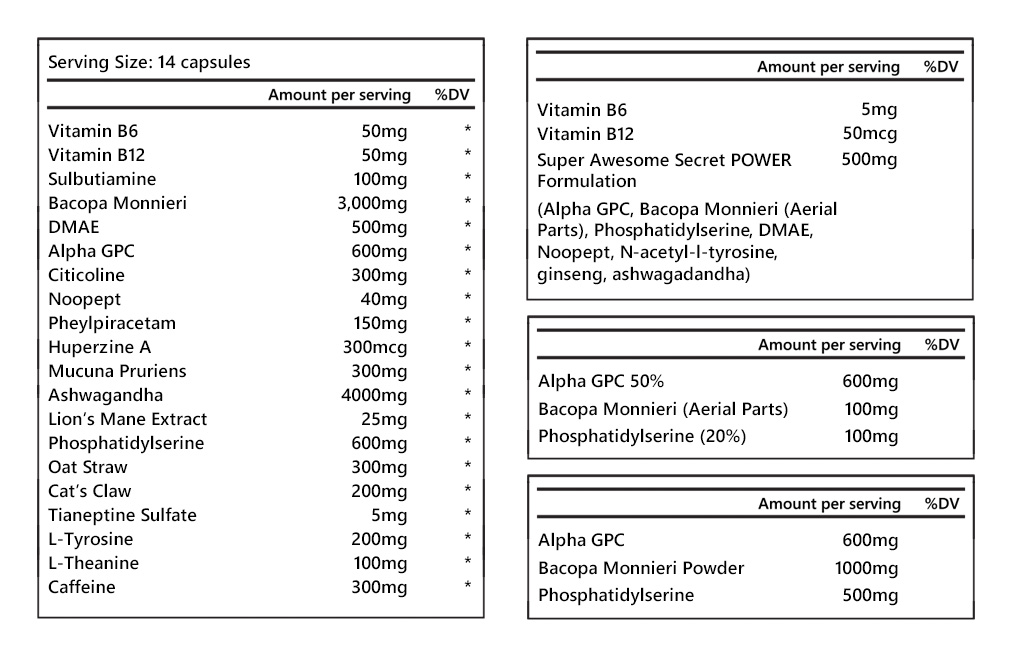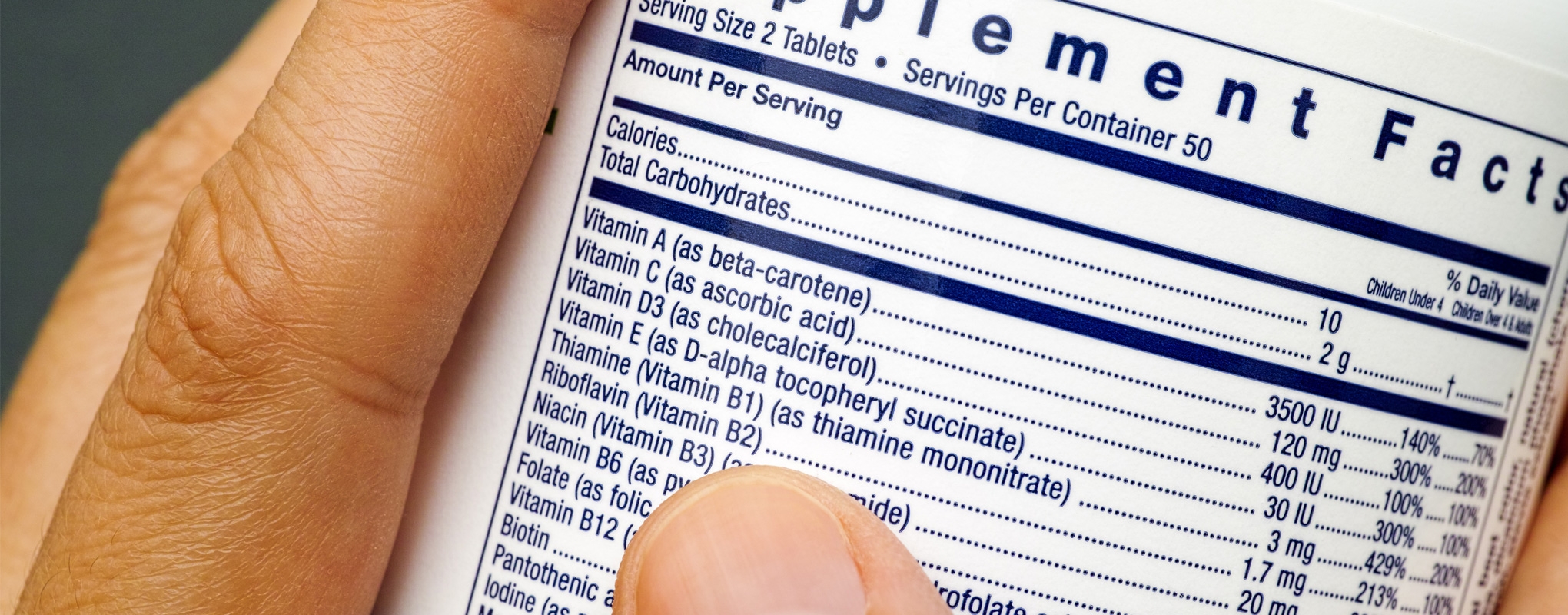Identifying Effective Nootropic Supplements
In a sea of nootropic blends and supplements, figuring out if a product is any good based on the ingredients it contains doesn't have to be an impossible task if you know what to look for.
We prepared a list of commonly found vitamins, minerals and extracts that are strong indicators of the quality and research that's gone into a product. Things that the company selling the products don't want you to know, because it would be painfully obvious that they are selling an inferior product, or trying to bamboozle you.
To begin with, here are some general guidelines to follow when first searching out a nootropic supplement, or any supplement for that matter:
- If a supplement formula is proprietary, you're better off finding another product. Proprietary formulas don't break down the individual dosages of their ingredients. Many companies will hide the dosages under the guise of 'protecting their product(s) from being copied'. This doesn't seem to be a widespread issue anymore. In reality, it's an easy way for them to underdose the compounds and maximize their profits.
- If a single product contains too many ingredients, it has been padded out to give you the impression that it's superior. It almost certainly is not. Taking too many ingredients at a time can have detrimental effects, and is a waste of money. Seek out formulas with lower amounts of higher quality ingredients at the right dosages instead, usually in the range of 4 - 8 compounds. Vitamin and Mineral formulations tend to be the only exceptions here.
- If the exact form of an ingredient or the active compounds it should contain aren't specified, you can assume it's probably not the kind you're looking for. Always ask the manufacturer for details, although these should be provided without asking. Most supplement manufacturers won't provide third-party analytical certificates, nor will they openly share the sources and forms of their ingredients - at least not without asking for them. This is simply because they know they are using inferior ingredients and they would rather that you blindly purchased without doing your research.
- If the product contains any botanical extracts, a Heavy Metal Analysis is essential. Do not buy any products containing extracts like Bacopa or Ashwagandha without this analysis, unless you're a fan of heavy metal poisoning. The exceptions here are if patented extracts such as Synapsa and Bacognize (both forms of Bacopa) or KSM-66 and Sensoril (forms of Ashwagandha) are used.
- If you're a stickler for every aspect for quality, choose only vegetarian capsules with no colorants. Gelatin based capsules are made from hydrolyzed beef collagen and colour capsules contain questionable additives.
These five simple guidelines will help you eliminate most poor, ineffective, and potentially harmful products.
Know Your Ingredients
Next, let's move onto the list of ingredients to look for.
You'll find at least a few of these in just about every nootropic and supplement blend on the market, so be sure you check and confirm before committing to a purchase.
Vitamin B12
Avoid: Cyanocobalamin. This form of Vitamin B12 is poorly absorbed by the body, and most supplements utilize this type.
Choose: Methylcobalamin. This is the most active form of Vitamin B12.
Dosage: At least 50mcg.
Magnesium
Avoid: Oxide - it is poorly tolerated and most commonly used.
Choose: Glycinate, Citrate, Orotate, or Threonate
Bonus: Magnesium Stearate is an excipient, or a flow agent and lubricant. Any company listing this as an active ingredient is absolutely clueless. Yes, sadly this does happen.
Dosage: Depends on the form. Ideally 100mg elemental magnesium - most supplements do not list the elemental magnesium content, but rather the form as a whole.
For example, Magnesium Glycinate is typically available in 10% - 18% concentrations, however, the Magnesium content for the Glycinate form is 14%. Any less and it's not pure, any more and it has been 'buffered' with another form of Magnesium. What this means is that 10% or 18% of the powder is elemental (active) magnesium, while the rest (in the case of Glycinate) is glycine.
So, 1,000mg of Magnesium Glycinate 18% contains 180mg of Magnesium and 820mg of Glycine. These additives are what differentiate the types of magnesium available, as well as their tolerance and effects.
Often, Magnesium is misleadingly labeled because not even the retailers or manufacturers are aware of the elemental magnesium content.
Zinc
Avoid: Oxide and Sulfate. Both forms have mixed results for bioavailability in the body.
Choose: Picolinate, Orotate, or Gluconate
Dosage: 10mg+
Vitamin B6
Adequate: Pyridoxine HCL
Optimal: P-5-P B6, which is once again the active form of the vitamin.
Dosage: 10mg+
Vitamin B9 (Folic Acid)
Suboptimal: Folic Acid
Optimal: Methylfolate, the active form of this vitamin.
Dosage: 300mcg+ for Methylfolate
Vitamin D3
Dosage: 3,000 IU minimum. Optimally 5,000 - 10,000 IU.
L-Theanine
There are no advantages to using a branded/patented form of L-Theanine, you will simply be paying more for the same ingredient. Years ago there were racemic mixes on the market, which contained both D- and L- isomers of the compound. Nowadays, 99% of all Theanine is L-Theanine only.
Dosage: 200mg
Lion's Mane Mushroom Extract
Avoid: Dosages lower than 1,000mg, if the Beta-Glucan content isn't specified or it if is not an extract. Polysaccharide content is generally meaningless. Learn more about Lion's Mane Extracts.
Dosage: 1,000 - 3,000mg.
Bacopa Monnieri
Avoid: Non-extracts, Leaf-extracts (sometimes referred to as "Aerial Parts") and forms where the Bacoside content is not listed. Extracts are not the same as just the powdered plant or roots - these are not standardized to anything, and therefore not guaranteed to contain any of the important Bacosides.
Bonus: HPLC verified extracts are more accurate than UV for Bacoside content. Our HPLC verified Bacopa extract is reported to exhibit less fatigue than other types.
Dosage: 320mg @ 55% Bacosides by UV. 50-300mg @ 50% Bacosides by HPLC.
Ashwagandha
Avoid: Leaf-only extracts. The leaves contain Withaferin-A which is cytotoxic, and the most effective extracts are based off of the roots primarily. The Sensoril brand is an exception here; it contains both roots and leaves but it is perfectly safe and also effective.
Look for: A stated withanolide content, between 1-5%.
Dosage: 300 - 800mg for 5% extracts. 1,000mg - 6,000mg for non-extracts.
Citicoline (CDP Choline)
Like L-Theanine, there are no advantages to using a branded/patented form of Citicoline. Both are equally effective.
Dosage: 150 - 250mg
Rhodiola Rosea
Rhodiola is standardized to Rosavins and Salidrosides if it is an extract. Rosavins are calming, Salidrosides are stimulating. Most contain a ratio of 3% Rosavins to 1% Salidrosides. Rosavin-containing extracts are significantly more expensive. Check the health benefits of rhodiola rosea.
Dosage: 250mg - 600mg with a 3/1 extract. 500mg for Salidroside-only extracts.
N-Acetyl-L-Tyrosine (NALT) / Tyrosine
The acetylated form of L-Tyrosine is known as NALT. On paper, regular L-Tyrosine may be more effective but the effects between the two vary from person to person.
NALT Dosage: 350mg+
L-Tyrosine Dosage: 500mg+
Huperzine A / Huperzia Serrata
Dosage: 30 - 50mcg if taken daily, 100mcg if regularly cycled.
Acetyl-L-Carnitine (ALCAR)
Dosage: 750mg
Phosphatidylserine
Phosphatidylserine is typical used as a 20% extract, meaning that you need at least 500mg to get the suggest dose of 100mg. 50% Extracts are also available, in which case only 200mg is required for the same dosage.
If the percentage is listed, then calculate accordingly. If it is not and the dosage is over 150mg, be wary. PS is not a cheap ingredient, 99% of supplements will not include more than 150mg of active PS. If they do, it will be expensive.
Dosage: 100mg+
Pyrroloquinoline Quinone (PQQ)
Dosage: 20mg based on published studies
DMAE
Dosage: 350mg
Vinpocetine
Dosage: 5 - 10mg is typically sufficient. Up to 20mg per serving is fine, any more may result in a headache.
Panax Ginseng
The active compounds are known as Ginsenosides. Available as Panax Ginseng Leaf Extract (cheaper) and root (more expensive) extracts. Just like Bacopa, Ginsenosides can be UV or HPLC identified - the latter being a more accurate measure and the more expensive form of Panax Ginseng
Dosage: 200mg+
Coenzyme Q10
Q10 is often underdosed because it is an expensive compound, appearing anywhere from 10-80mg. In reality, your dose should be between 100 - 300mg depending on your age and use case.
Dosage: 100mg+
Alpha GPC
Alpha GPC is available in 50% and 99% forms. Due to how hygroscopic GPC is (it draws in moisture from the air), the 50% form is exclusively used in powder supplement formulations. Many people don't realize this, and this is exactly why the dosages can be misleading if not labeled correctly. "Alpha GPC 50%" on a label means that you are only getting half the amount listed when it comes to pure GPC - the rest is usually silica that prevents it from absorbing moisture and ruining the capsule it is in. There is no difference between the two forms other than the dosage.
Dosage: Typically 300 - 600mg (or 600 - 1,200mg if it is Alpha GPC 50%). Lower dosages are not a bad thing depending on the formula, but anything less than 150mg is generally going to be negligible in effect.
Examples of Misleading Product Labeling
To summarize, we'll provide a few examples of some misleadingly labeled and poorly/dangerously formulated supplements below. These are fictional, but we have seen these types of practices appear in various products. Malicious or not, it's important to learn how to identify these nuances in product labels.
If you have any questions, let us know in the comments below.

